|
Author
|
Topic: STS-120: Reentry and landing
|
Robert Pearlman
Editor Posts: 42988
From: Houston, TX
Registered: Nov 1999
|
 posted 11-05-2007 02:47 PM
posted 11-05-2007 02:47 PM
   
Deorbit Opportunities for STS-120 (all times are CST)
Updated: November 6, 2007| Date | Orbit | Site | TIG | Landing | | | | | | | | Wed, Nov. 7 | 238 | KSC | 10:59 a.m. | 12:02 p.m. | | 239 | KSC | 12:34 p.m. | 1:36 p.m. | | | | | | | | Thu, Nov. 8 | 253 | KSC | 9:33 a.m. | 10:33 a.m. | | 254 | EDW | 10:58 a.m. | 12:00 p.m. | | | NOR | 11:01 a.m. | 12:03 p.m. | | | KSC | 11:09 a.m. | 12:08 p.m. | | 255 | EDW | 12:34 p.m. | 1:35 p.m. | | | NOR | 12:37 p.m. | 1:37 p.m. | | 256 | EDW | 2:09 p.m. | 3:08 p.m. | | | | | | | | Fri, Nov. 9 | 269 | KSC | 9:39 a.m. | 10:39 a.m. | | 270 | EDW | 11:04 p.m. | 12:06 p.m. | | | NOR | 11:08 a.m. | 12:09 p.m. | | | KSC | 11:15 a.m. | 12:13 p.m. | | 271 | EDW | 12:40 p.m. | 1:40 p.m. | | | NOR | 12:43 p.m. | 1:42 p.m. | TIG = Time of Ignition for Deorbit Burn
KSC = Kennedy Space Center
EDW = Edwards Air Force Base
NOR - Northrup Flight Strip (White Sands) |
Deorbit Timeline for the First KSC Landing Opportunity November 7
(all times are CST) | 7:03 a.m. | Deorbit Prep begins | | 8:15 a.m. | Payload Bay Door closing | | 8:35 a.m. | Transition to Reentry Software (Ops 3) | | 9:35 a.m. | Donning ACES flight suits | | 10:10 a.m. | Seat ingress | | 10:15 a.m. | OMS Gimbal Check | | 10:30 a.m. | APU Prestart | | 10:40 a.m. | "Go-No Go" decision for deorbit burn | | 10:48 a.m. | Maneuver for deorbit burn attitude | | 10:59 a.m. | Deorbit burn | | 12:01:50 p.m. | KSC landing | |
Robert Pearlman
Editor Posts: 42988
From: Houston, TX
Registered: Nov 1999
|
 posted 11-05-2007 02:54 PM
posted 11-05-2007 02:54 PM
   
STS-120 Landing Ground Tracks for KSC Landing OpportunitiesOrbit 238
TIG: 10:59:12 CST
Landing: 12:01:50 CST 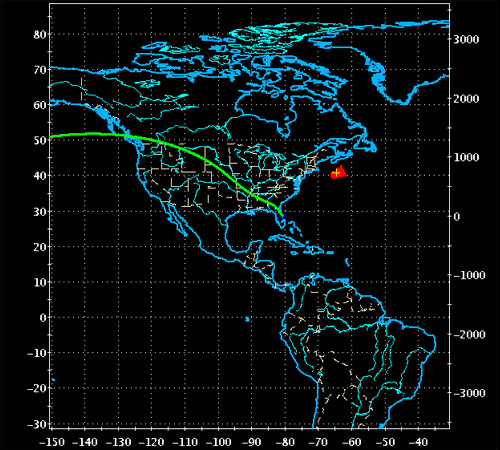
Orbit 239
TIG: 12:34:42 CST
Landing: 1:36:12 CST 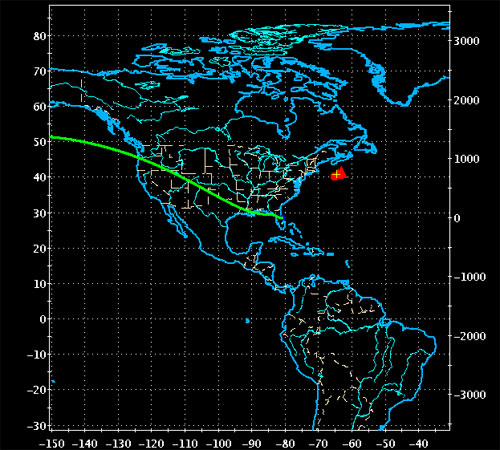
You can find additional details and maps on NASA's website. |
Robert Pearlman
Editor Posts: 42988
From: Houston, TX
Registered: Nov 1999
|
 posted 11-05-2007 03:17 PM
posted 11-05-2007 03:17 PM
   
With regards to the weather, from today's (FD14) execute package: quote:
Landing Weather - The MMT [Mission Management Team] took a quick look at EOM [End of Mission] KSC weather. A dry front is predicted to move through KSC about 12 hours before landing resulting in strong head winds on the 33 approach but still within Flight Rule limits. A full entry brief will be provided to the MMT tomorrow including the complete weather forecast.
|
Jay Chladek
Member Posts: 2272
From: Bellevue, NE, USA
Registered: Aug 2007
|
 posted 11-05-2007 09:47 PM
posted 11-05-2007 09:47 PM
   
Wow, when was the last time they did a descending node trajectory for landing? I don't recall them ever doing one for an ISS flight and certainly not since STS-107.Looks like I might have to take a drive a little west of Lincoln, NE to get under this in order to watch it. But, if they do come down on the first attempt, it should make for quite a show since they should be around 230,000 feet when they come roaring overhead. |
Ben
Member Posts: 1896
From: Cape Canaveral, FL
Registered: May 2000
|
 posted 11-05-2007 10:43 PM
posted 11-05-2007 10:43 PM
   
I think STS-99 was the last high-incl one. |
Robert Pearlman
Editor Posts: 42988
From: Houston, TX
Registered: Nov 1999
|
 posted 11-06-2007 07:48 AM
posted 11-06-2007 07:48 AM
   
From today's (FD15) execute package: quote:
Entry Plan - Entry Flight Director/Bryan Lunney briefed the entry plan at today's MMT [Mission Management Team]. The limiting orbiter consumable will be supply water with at least 7 deorbit opportunities available over 3 days. The remaining orbiter consumables will support EOM [End of Mission] +3 with at least 2 opportunities per day. The plan is to target two KSC opportunities for EOM on orbits 238 and 239. In the event of an EOM wave-off, EDW may be considered on EOM+1 pending the latest weather forecast and all three sites (KSC, EDW, NOR) will be activated on EOM+2.
Entry Landing Site/Weather - All three landing sites are ready with nominal convoy support, landing aids, and navigation aids. Both the EDW and NOR lakebeds are green. A dry front will pass through KSC early Wednesday morning. This front is forecast to leave behind dry, cool air and a GO forecast with a head wind of 14P23 knots on KSC runway 33. EOM+1 has a GO forecast for EDW and NOR while KSC has a chance of precipitation and a chance of ceilings. EOM+2 has a GO forecast for KSC and NOR while EDW has a slight chance for virga.
|
garymilgrom
Member Posts: 1966
From: Atlanta, GA
Registered: Feb 2007
|
 posted 11-06-2007 08:38 AM
posted 11-06-2007 08:38 AM
   
Robert thank you for posting these maps. It looks like the Shuttle will fly very close to Columbus GA, which is a short drive from home. However is there a way to find out how high it will be (when it crosses the 32.5 degrees marking)? It may be too high to see at this point. Thank you. |
Jay Chladek
Member Posts: 2272
From: Bellevue, NE, USA
Registered: Aug 2007
|
 posted 11-06-2007 09:20 AM
posted 11-06-2007 09:20 AM
   
In your case gary it might be too low to see rather then too high. The altitude I am estimating for the Nebraska pass should be 200,000 plus feet (about 230 or so I would say) and I am figuring it should be visible as a glowing object since Columbia was over Dallas when it finally broke up and it was very visible in the daytime. By the time it is over Georgia, it will be deeper in the atmosphere and probably not as visible since I don't think it will be producing a plasma trail at that point (it would probably show up on an infrared camera though).But, I wouldn't be surprised if you heard a sonic boom where you are. I doubt a boom will be heard in my area due to the extreme altitude when it passes overhead. But I will be listening. |
Robert Pearlman
Editor Posts: 42988
From: Houston, TX
Registered: Nov 1999
|
 posted 11-06-2007 02:32 PM
posted 11-06-2007 02:32 PM
   
Description of ground tracks for entry WednesdayOrbit 328 - Crossing over North America from the North West to South Eart
- Start over west coast of British Columbia near Vancouver
- Cross over
- Montana
- Northeast corner of Wyoming
- Southwest corner of South Dakota (Rapid City)
- Central Nebraska
- Northeast Kansas (Topeka)
- Southwest corner of Missouri
- Northeast Arkansas
- Tennessee (Memphis)
- Northeast corner of Mississippi
- Alabama (Birmingham)
- Georgia (Columbus)
- Across northern border of Florida toward east coast (between Orlando and Daytona Beach) and KSC.
Orbit 239 - Crossing over North America from the North West to South East.
- Shallower track over Southwestern United States than first opportunity
- Start over the west coast of Oregon near Portland.
- Cross over
- Southwest corner of Idaho
- Utah (Salt Lake City)
- Colorado
- Northeast corner of New Mexico
- Panhandle of Texas (Amarillo, Wichita Falls, Dallas-Forth Worth)
- Lousiana
- Skirts along the coast and over the Gulf before crossing over the west coast of Florida near Cedar Key and Waccasassa Bay, heading east just north of Orlando to KSC.
|
jameskelley97
New Member Posts:
From:
Registered:
|
 posted 11-06-2007 02:38 PM
posted 11-06-2007 02:38 PM
   
wish i could watch from where i am upstate new york |
garymilgrom
Member Posts: 1966
From: Atlanta, GA
Registered: Feb 2007
|
 posted 11-06-2007 03:55 PM
posted 11-06-2007 03:55 PM
   
Thank you for the info Jay. |
buckeyecal
Member Posts: 90
From: soon to be Boise, ID USA
Registered: Feb 2006
|
 posted 11-06-2007 05:25 PM
posted 11-06-2007 05:25 PM
   
Hey Robert, do you happen to have a exact time it starts passing Montana? I live in Boise and was wondering if it was visible on reentry from the vantage point up here.Thanks, Daniel |
SpaceDust
Member Posts: 115
From: Louisville, Ky USA
Registered: Mar 2006
|
 posted 11-06-2007 07:33 PM
posted 11-06-2007 07:33 PM
  
NASA use to put this kind of information out for telling people what the ground track would be as in, what cities it would be visible from, how high, what direction to look in, etc. I've been trying to find this data for two days and can't find a thing on it. Wonder why NASA doesn't do it anymore? I'm going to give it a shot to find it on the first attempt but I'm sure it will be to low on the horizon. |
Ben Watson
Member Posts: 24
From: Jackson, MS USA
Registered: Dec 2002
|
 posted 11-06-2007 08:22 PM
posted 11-06-2007 08:22 PM
   
If a descending node landing trajectory is possible, is it also possible to launch in a descending node trajectory? I presume that it is possible, but that it is not done because of a lack of available TAL abort sites. Does anyone know the answer? |
Ben
Member Posts: 1896
From: Cape Canaveral, FL
Registered: May 2000
|
 posted 11-06-2007 08:23 PM
posted 11-06-2007 08:23 PM
   
Yes, but the reason is that they cannot launch to the south from Cape Canaveral as they would overfly the Bahamas and other Carribean islands. |
Jay Chladek
Member Posts: 2272
From: Bellevue, NE, USA
Registered: Aug 2007
|
 posted 11-06-2007 08:40 PM
posted 11-06-2007 08:40 PM
   
They would also fly over Cuba as well, depending on the orbit track. Because of that, I believe this is the main reason they didn't select any TAL sites for that direction. |
CosmicKnight
New Member Posts: 7
From: Alabama, USA
Registered: Jan 2006
|
 posted 11-07-2007 06:55 AM
posted 11-07-2007 06:55 AM
   
quote:
Originally posted by Jay Chladek:
By the time it is over Georgia, it will be deeper in the atmosphere and probably not as visible since I don't think it will be producing a plasma trail at that point (it would probably show up on an infrared camera though). But, I wouldn't be surprised if you heard a sonic boom where you are.
I work in Columbus, GA and live not too far away in Alabama, and we have heard sonic booms from the Shuttle in this area before. I will definitely plan to listen and look if the first landing opportunity is utilized.Like SpaceDust posted above, I wish I had more details, especially *when* Discovery will pass over the area. The best ideas I have at the moment are to follow the progress through the Spaceflight Now updates page or NASA TV online then go out a little early. |
Robert Pearlman
Editor Posts: 42988
From: Houston, TX
Registered: Nov 1999
|
 posted 11-07-2007 08:22 AM
posted 11-07-2007 08:22 AM
   
The crew of space shuttle Discovery has closed the orbiter's payload bay doors in preparation for landing today at the Kennedy Space Center. |
Robert Pearlman
Editor Posts: 42988
From: Houston, TX
Registered: Nov 1999
|
 posted 11-07-2007 08:39 AM
posted 11-07-2007 08:39 AM
   
Flight controllers in Houston have given the "go" to Discovery's crew to transition the orbiter's on-board software to its reentry configuration (Ops 3). |
Lunar rock nut
Member Posts: 911
From: Oklahoma city, Oklahoma U.S.A.
Registered: Feb 2007
|
 posted 11-07-2007 09:03 AM
posted 11-07-2007 09:03 AM
   
Current conditions at the cape can be seen via NWS.Terry |
Robert Pearlman
Editor Posts: 42988
From: Houston, TX
Registered: Nov 1999
|
 posted 11-07-2007 10:49 AM
posted 11-07-2007 10:49 AM
   
Entry Team Flight Director Bryan Lunney and his team have given the go for Discovery’s reentry and landing with the deorbit burn set for 10:59 a.m. CST.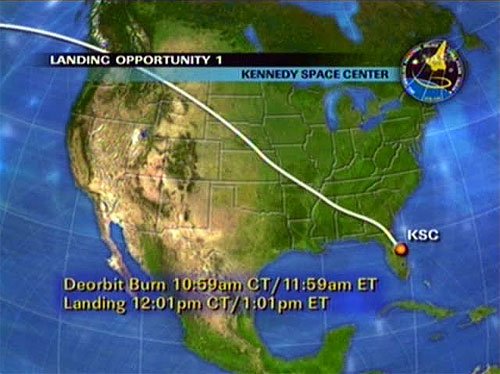
The 1 minute, 58 second burn will slow the shuttle by 148 miles per hour (217 feet per second) for the reentry across the heartland of the United States traveling from the northwest to southeast. |
Robert Pearlman
Editor Posts: 42988
From: Houston, TX
Registered: Nov 1999
|
 posted 11-07-2007 10:59 AM
posted 11-07-2007 10:59 AM
   
Space shuttle Discovery has begun its deorbit burn, bringing it out of orbit and on a path to land at the Kennedy Space Center in just over an hour from now. |
Robert Pearlman
Editor Posts: 42988
From: Houston, TX
Registered: Nov 1999
|
 posted 11-07-2007 11:01 AM
posted 11-07-2007 11:01 AM
   
The deorbit burn has been successfully completed. "Discovery, Houston, good burn, no trim required," radioed Mission Control to the STS-120 crew. |
Robert Pearlman
Editor Posts: 42988
From: Houston, TX
Registered: Nov 1999
|
 posted 11-07-2007 11:04 AM
posted 11-07-2007 11:04 AM
   
A current view of the Shuttle Landing Facility from the top of the Vehicle Assembly Building:
|
Robert Pearlman
Editor Posts: 42988
From: Houston, TX
Registered: Nov 1999
|
 posted 11-07-2007 11:12 AM
posted 11-07-2007 11:12 AM
   
Fifty minutes until touchdown.Discovery is setting up to land from the southeast on Runway 33, making a right overhead turn as it approaches Kennedy's Shuttle Landing Facility. |
Robert Pearlman
Editor Posts: 42988
From: Houston, TX
Registered: Nov 1999
|
 posted 11-07-2007 11:30 AM
posted 11-07-2007 11:30 AM
   
Thirty-one minutes before touchdown. Discovery has begun entering the atmosphere ("entry interface") at an altitude of around 400,000 feet as it passes over the northern Pacific Ocean. The current weather conditions at the Shuttle Landing Facility have winds from the north at 12 knots with gusts up to 18 knots, a few clouds at 47,000 feet, visibility is unrestricted, and the temperature is 70 degrees (F). |
Robert Pearlman
Editor Posts: 42988
From: Houston, TX
Registered: Nov 1999
|
 posted 11-07-2007 11:41 AM
posted 11-07-2007 11:41 AM
   
Twenty-one minutes to touchdown.Discovery's landing path crosses diagonally over North America from northwest to southeast. Entering over the west coast of British Columbia north of Vancouver, the shuttle will fly over the states of Montana, Wyoming, South Dakota, Nebraska, Kansas, Missouri, Arkansas, Tennessee, Mississippi, Alabama and Georgia before crossing the northern border of Florida and heading toward the east coast on its final approach to Kennedy Space Center. |
Robert Pearlman
Editor Posts: 42988
From: Houston, TX
Registered: Nov 1999
|
 posted 11-07-2007 11:52 AM
posted 11-07-2007 11:52 AM
   
Ten minutes to touchdown, Discovery is traveling at 4,000 mph at an altitude of 132,000 feet, just 240 miles from Kennedy Space Center. |
Robert Pearlman
Editor Posts: 42988
From: Houston, TX
Registered: Nov 1999
|
 posted 11-07-2007 11:57 AM
posted 11-07-2007 11:57 AM
   
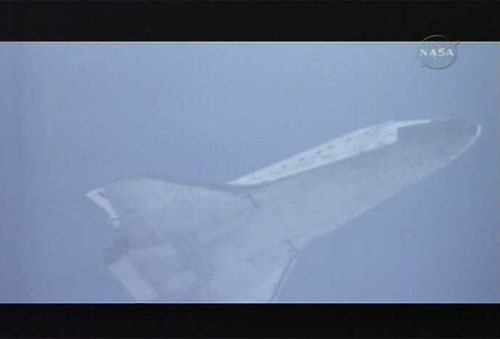 Five minutes to touchdown. |
Robert Pearlman
Editor Posts: 42988
From: Houston, TX
Registered: Nov 1999
|
 posted 11-07-2007 12:01 PM
posted 11-07-2007 12:01 PM
   
Touchdown! Space shuttle Discovery has landed on Runway 33 at the Kennedy Space Center's Shuttle Landing Facility in Florida."Houston, Discovery, wheels stop," announced STS-120 commander Pam Melroy at 12:02:13 p.m. CST. "Copy wheels stop Discovery, congratulations on a tremendous mission and a great landing Pam," replied capcom Terry Virts. 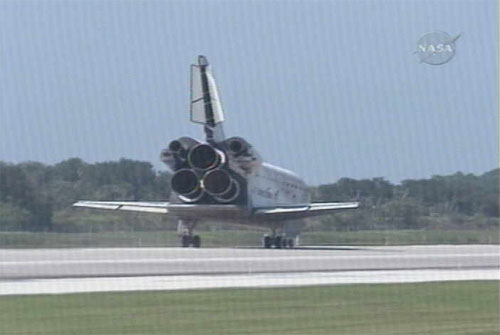
The landing brings to an end Discovery's 34th mission, the 23rd shuttle flight to the International Space Station and the 120th mission of the shuttle program. STS-120 is the 66th mission to land in Florida and the 51st to land at KSC during the day. At a mission duration of 15 days, 2 hours, 23 minutes and 55 seconds, STS-120 is the ninth longest shuttle flight. Discovery traveled a total of 6,249,432 miles during 238 orbits of the Earth. The six member STS-120 crew, led by commander Pam Melroy, was accompanied for the ride home by returning ISS Expedition 15/16 resident Clay Anderson, who had been in space for 152 days. |
LadyCosmos
New Member Posts:
From:
Registered:
|
 posted 11-07-2007 12:04 PM
posted 11-07-2007 12:04 PM
   
Welcome home...LadyCosmos |
NavySpaceFan
Member Posts: 655
From: Norfolk, VA
Registered: May 2007
|
 posted 11-07-2007 12:09 PM
posted 11-07-2007 12:09 PM
   
Smooth landing!!!! If she were Navy, I'd say COL Melroy caught the three wire! |
Robert Pearlman
Editor Posts: 42988
From: Houston, TX
Registered: Nov 1999
|
 posted 11-07-2007 12:24 PM
posted 11-07-2007 12:24 PM
   
Discovery's main gear touched down at 12:01:18 p.m. CST at a mission elapsed 15 days, 2 hours and 23 minutes.Nose gear touchdown was 14 seconds later at 12:01:32 p.m. (15 days, 2 hours, 23 minutes and 14 seconds). STS-120 commander Pamela Melroy announced "wheels stop" at 12:02:13 p.m. (15 days, 2 hours, 23 minutes and 55 seconds). |
Russ Still
Member Posts: 535
From: Atlanta, GA USA
Registered: Nov 1999
|
 posted 11-07-2007 01:19 PM
posted 11-07-2007 01:19 PM
   
I heard the sonic boom as it passed over south Georgia. |
Robert Pearlman
Editor Posts: 42988
From: Houston, TX
Registered: Nov 1999
|
 posted 11-07-2007 01:44 PM
posted 11-07-2007 01:44 PM
   
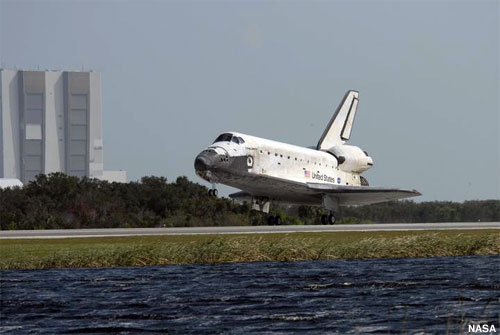 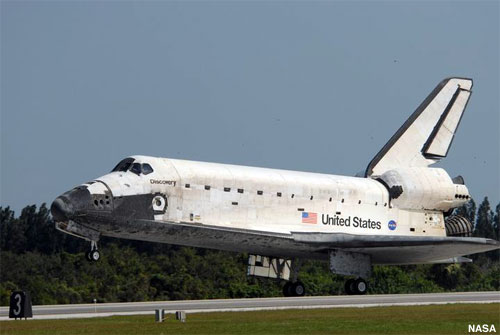
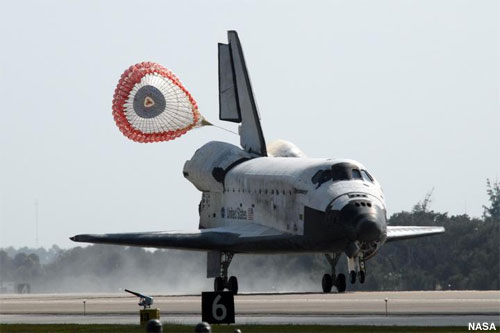
|
GACspaceguy
Member Posts: 2475
From: Guyton, GA
Registered: Jan 2006
|
 posted 11-07-2007 01:59 PM
posted 11-07-2007 01:59 PM
   
quote:
Originally posted by NavySpaceFan:
Smooth landing!!!! If she were Navy, I'd say COL Melroy caught the three wire!
I managed to get away and watch the landing as shown on the NASA channel. I thought that she "planted" the last ten feet or so of the vertical descent. I was wondering if this may have been due to the head winds and not wanting it to "float" down the runway. I will need to see the replays tonight to verify this. Any comments by those who also saw the landing? |
Jay Chladek
Member Posts: 2272
From: Bellevue, NE, USA
Registered: Aug 2007
|
 posted 11-07-2007 02:06 PM
posted 11-07-2007 02:06 PM
   
No joy on seeing it as it looks like the final reentry track took it still further to the west then I first thought, probably over Grand Island. I parked myself at a small airport in Seward, NE, about 20 miles to the west of Lincoln. High cirrus clouds also obscured my view a bit.However, at about 11:46AM, I did hear a distinct sonic boom. It was faint, but unmistakable. I went into a closed hangar and even the mechanics inside working on aircraft heard it. Pretty cool stuff.  Welcome home STS-120! And thanks to Pam Melroy for helping to give NASA the incentive to do a descending node reentry on this mission. |
Robert Pearlman
Editor Posts: 42988
From: Houston, TX
Registered: Nov 1999
|
 posted 11-07-2007 02:22 PM
posted 11-07-2007 02:22 PM
   
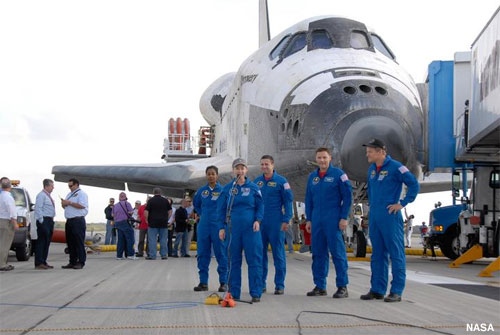 STS-120 commander Pam Melroy led her crewmates George Zamka, Scott Parazynski, Doug Wheelock and Stephanie Wilson on the traditional walkaround of their orbiter post-landing. ESA astronaut Paolo Nespoli and returning ISS resident Clay Anderson stayed within the crew transport vehicle to undergo additional medical tests, as Melroy explained in her comments: quote:
It's great to be out here on this gorgeous day, it's a little breezy.It's great to be back in Florida, especially the home of Discovery. We could not have done this mission without Discovery being as clean and beautiful as it was. Discovery worked perfectly and I just want to say a big thank you to everybody at the Kennedy Space Center for everything that you do because it takes the entire team to pull it together to launch a shuttle as clean as this. And that goes for the whole agency! I think that the whole agency had to pull together for this particular mission. We saw a lot of unusual things happen, we did a pretty amazing EVA and that was very exciting. It was a thrilling day for both the space shuttle and the space station programs, vindicating both programs in their purpose and their flexibility in space. I just want to say thank you, we are thrilled to be back home. Sorry that Clay and Paolo couldn't be out here, they're doing great, they're just doing some extra medical tests, so they couldn't join us right now, but I know they feel the same way, particularly Clay can't wait to see his wife Susan, it's their 15th wedding anniversary. So if you see Clay be sure to say happy anniversary and thank you everybody for a beautiful vehicle and a beautiful mission.
|
kimmern123
Member Posts: 83
From: Norway
Registered: Dec 2006
|
 posted 11-07-2007 04:22 PM
posted 11-07-2007 04:22 PM
   
quote:
Originally posted by GACspaceguy:
I managed to get away and watch the landing as shown on the NASA channel. I thought that she "planted" the last ten feet or so of the vertical decent. I was wondering if this may have been due to the head winds and not wanting it to "float" down the runway. I will need to see the replays tonight to verify this. Any comments by those who also saw the landing?
I'm very interested in the landings of the space shuttle and pay close attention to them, especially the sink rate just before touchdown. Pambo did indeed "plant" it a little during the last few feet. The headwainds were up to 23 knots which is pretty close to the flight rule limits (25 knots). It seems she also touched down a little early at a bit too high speed, judging from the time she derotated the nose. That happens at 185-180 knots and the nose was up much longer than other landings I've seen with touchdown points at 195 knots. But, hey, I'm knitpicking. What a great landing by Pambo. She did a magnificent job based on the landing conditions and I don't think anyone could've done a better job. |
ejectr
Member Posts: 1751
From: Killingly, CT
Registered: Mar 2002
|
 posted 11-07-2007 06:32 PM
posted 11-07-2007 06:32 PM
   
She certainly split that centerline. I was looking at the nose wheel perfectly dissecting the paint stripe as it sat on the runway.She knew exactly what she was doing and why landing that bird the way she did. Good job, Pam. You ran a tight ship and everyone had fun, too. Can't get any better than that. |






















